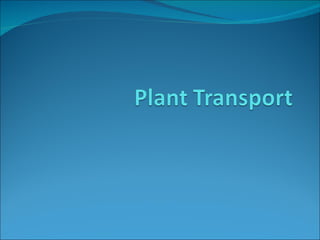Plant transport ppt
•Als PPT, PDF herunterladen•
14 gefällt mir•30,073 views
Melden
Teilen
Melden
Teilen

Weitere ähnliche Inhalte
Was ist angesagt?
Was ist angesagt? (20)
Andere mochten auch
Andere mochten auch (14)
Photosynthesis PPT FOR CLASS 9,10 and 11Th students

Photosynthesis PPT FOR CLASS 9,10 and 11Th students
Transport in plants 7 translocation of assimilates

Transport in plants 7 translocation of assimilates
Ähnlich wie Plant transport ppt
Ähnlich wie Plant transport ppt (20)
BIO 2203 Lecture 3 WATER TRANSPORT or TRANSLOCATION.pptx

BIO 2203 Lecture 3 WATER TRANSPORT or TRANSLOCATION.pptx
5. water -importance and significance-2014 M.Sc -E.pptx

5. water -importance and significance-2014 M.Sc -E.pptx